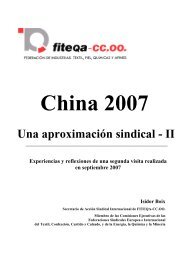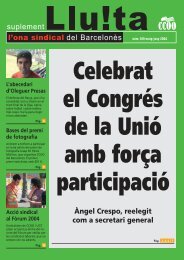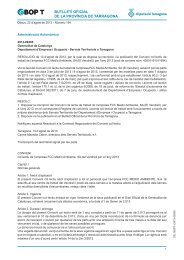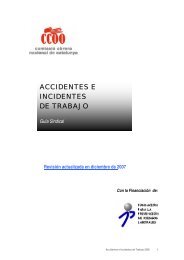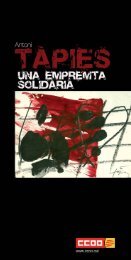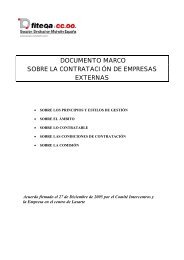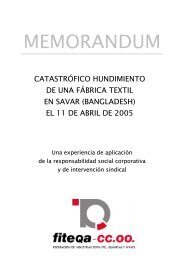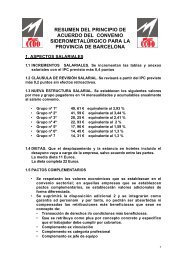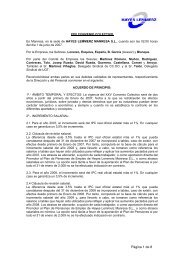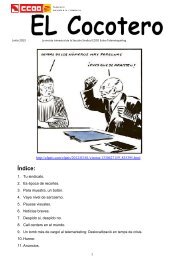el ambiente psicosocial de trabajo y la salud - CCOO de Catalunya
el ambiente psicosocial de trabajo y la salud - CCOO de Catalunya
el ambiente psicosocial de trabajo y la salud - CCOO de Catalunya
You also want an ePaper? Increase the reach of your titles
YUMPU automatically turns print PDFs into web optimized ePapers that Google loves.
54 ESTADO DE LA CUESTIÓN<br />
Tamaño muestral: 7.650 personas (error muestral máximo d<strong>el</strong> ±1,14 en condiciones <strong>de</strong> P=Q=50% y niv<strong>el</strong><br />
<strong>de</strong> confianza d<strong>el</strong> 95,5% 2 ).<br />
Trabajo <strong>de</strong> campo: <strong>el</strong> <strong>trabajo</strong> <strong>de</strong> campo lo realizó CUANTER SA, con supervisión propia y secundaria <strong>de</strong><br />
ISTAS. Tasa <strong>de</strong> respuesta (antes <strong>de</strong> sustituciones): 60%. Sustituciones protocolizadas posteriores al tercer<br />
intento <strong>de</strong> contacto con distinto horario fallido o a <strong>la</strong> negativa explícita. Mismos criterios <strong>de</strong> inclusión y<br />
s<strong>el</strong>ección, en <strong>la</strong> misma oleada, sección censal y ruta <strong>de</strong> <strong>la</strong> inci<strong>de</strong>ncia. La <strong>de</strong>scripción y análisis más <strong>de</strong>tal<strong>la</strong>do<br />
d<strong>el</strong> muestreo y d<strong>el</strong> <strong>trabajo</strong> <strong>de</strong> campo está disponible xxxiii .<br />
Medida <strong>de</strong> <strong>la</strong>s exposiciones a factores <strong>psicosocial</strong>es: 21 esca<strong>la</strong>s (73 ítems tipo Likert <strong>de</strong> 5 categorías <strong>de</strong><br />
respuesta) <strong>de</strong> <strong>la</strong> versión media d<strong>el</strong> cuestionario validado anteriormente <strong>de</strong> ISTAS21 COPSOQxxxiv, versión<br />
españo<strong>la</strong> d<strong>el</strong> COPSOQxxxv. Las <strong>de</strong>finiciones <strong>de</strong> todas <strong>la</strong>s dimensiones, ítems que <strong>la</strong>s integran y <strong>de</strong>más características<br />
d<strong>el</strong> cuestionario ISTAS21 COPSOQ pue<strong>de</strong>n obtenerse <strong>de</strong> su manual <strong>de</strong> referencia xxxvi .<br />
El cuestionario incluía preguntas para <strong>la</strong> caracterización socio<strong>de</strong>mográfica <strong>de</strong> <strong>la</strong>s personas (edad, sexo, estudios<br />
realizados, país <strong>de</strong> origen) y su entorno familiar (estado civil, hijos y convivencia con personas <strong>de</strong>pendientes<br />
y eda<strong>de</strong>s <strong>de</strong> éstas, realización <strong>de</strong> <strong>trabajo</strong> doméstico y familiar), actividad (CNAE) <strong>de</strong> <strong>la</strong> empresa,<br />
c<strong>la</strong>se social (ocupación actual), condiciones <strong>de</strong> empleo (r<strong>el</strong>ación <strong>la</strong>boral…) y <strong>de</strong> <strong>trabajo</strong> (ingresos, jornada,<br />
horario...).<br />
Análisis: basado en <strong>la</strong> personas para <strong>la</strong>s que su r<strong>el</strong>ación <strong>la</strong>boral <strong>de</strong>c<strong>la</strong>rada es asimi<strong>la</strong>ble a “asa<strong>la</strong>riada”<br />
(N=7456), aunque normativamente incluye personas que no lo son (funcionarios, autónomos <strong>de</strong>pendientes<br />
y sin contrato). Se abordó en cuatro fases: 1) Caracterización <strong>de</strong> <strong>la</strong>s prácticas <strong>de</strong> gestión <strong>de</strong> <strong>la</strong> mano <strong>de</strong><br />
obra, en base a pan<strong>el</strong>es <strong>de</strong> expertos. 2) Análisis <strong>de</strong>scriptivo <strong>de</strong> todas <strong>la</strong>s variables, atendiendo a los principales<br />
ejes <strong>de</strong> segregación: ocupación, sexo, r<strong>el</strong>ación <strong>la</strong>boral, edad, país <strong>de</strong> origen; también se tuvo en<br />
cuenta <strong>el</strong> sector y <strong>la</strong> presencia sindical en <strong>el</strong> centro. 3) Análisis bivaridado: Tab<strong>la</strong>s contingencia (chi cuadrado,<br />
residuos estandarizados) y corr<strong>el</strong>aciones. 4) Análisis multivariado: Variables <strong>de</strong>pendientes: prevalencias<br />
<strong>de</strong> exposición a los 21 riesgos. Mod<strong>el</strong>os <strong>de</strong> regresión logística saturados: cálculo <strong>de</strong> Odds Ratios,<br />
ORaj IC 95%, estadísticos <strong>de</strong> ajuste: Homer Lemeshow y tab<strong>la</strong>s <strong>de</strong> c<strong>la</strong>sificación.<br />
REFERENCIAS<br />
i The European Heart Network. Expert Group on Psychosocial and Occupation Factors. Social factors, stress and cardiovascu<strong>la</strong>r disease<br />
prevention in the European Union. Bruss<strong>el</strong>s: European Heart Network 1998.<br />
ii Kristensen TS. Job stress and cardiovascu<strong>la</strong>r disease: a theoretic critical review. J Occup Health Psychol 1996;1(3):246-260.<br />
iii Schnall PL, B<strong>el</strong>kinc K, Landsbergis P, Baker D (Editores). The workp<strong>la</strong>ce and cardiovascu<strong>la</strong>r disease. Occupational Medicine: State of<br />
the Art Reviews 2000;15:1-334.<br />
iv Kivimäki M, Leino-Arjas P, Luukkonen R, Riihimäki H, Vathera J, Kirjonen J. Work stress and risk of cardiovascu<strong>la</strong>r mortality: prospective<br />
cohort study of industrial employees. Br Med J 2002; 325(7369):857-861.<br />
v Stansf<strong>el</strong>d S, Marmot M (Editores). Stress and the heart. Psychosocial pathways to coronary heart disease. London: BMJ Books 2002.<br />
vi Kuper H, Marmot;. Job strian, job <strong>de</strong>mands, <strong>de</strong>cisión <strong>la</strong>titu<strong>de</strong>, and risk of coronary heart disease within the Whitehall II study. J Epiemiol<br />
Community Health 2003;57:147-153.<br />
vii Smyth JM et al. Daily psychosocial factors predict lev<strong>el</strong>s and diurnal cycles of asthma and peack flow. J Behav Med 1999;22(2):179-<br />
193.<br />
viii Räihä I et al. Lifestyle, stress and genes in peptic ulcer disease: a nationwi<strong>de</strong> twin cohort study. Arch Int Med 1998; 158(7):698-704.<br />
ix Fukudo S, Suzuki J. Colonic motility, autonomic function and gastrointestinal hormones un<strong>de</strong>r psychological stress on irritable bow<strong>el</strong><br />
syndrome. Tohocu J Exp Med 1987;151(4):373-385.<br />
x Paar GH et al. The corr<strong>el</strong>ation of psychosocial stress and disease activity in patients with Crohn disease and ulcerative colitis. Z gastroenterol<br />
1998;26(10):648-657.<br />
xi Levenstein S et al. Stress and exacerbation in ulcerative collitis: a prospective study of patients enrolled in remission. Am J Gastroenterol<br />
2000;95(5):1213-1220.<br />
xii Karasek R. Job <strong>de</strong>mands, job <strong>de</strong>cission <strong>la</strong>titu<strong>de</strong> and mental strain: implications for job re-<strong>de</strong>sign. Admins Sci Q 1979;24:285-308.<br />
xiii Johnson JV, Hall E. Job strain, work p<strong>la</strong>ce social support and cardiovascu<strong>la</strong>r disease: a cross-sectional study of a random sample of<br />
the Swedish working popu<strong>la</strong>tion. Am J Public Health 1988;78(10):1336-1342.



